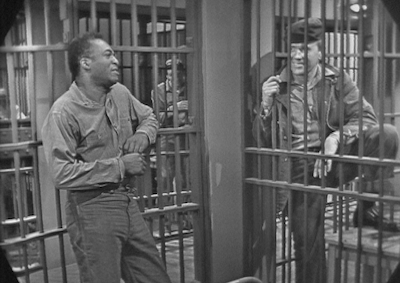Read a Q&A with Ina Archer, Media Conservation & Digitization Specialist, National Museum of African American History and Culture.
In 1961, when there was virtually little to no representation of African Americans in creative roles above the line in broadcast television, trailblazer Robert L. Goodwin took matters into his own hands and wrote, produced and co-starred in his own highly accomplished video drama titled The Upper Chamber.
Starring Academy Award nominee Lew Ayres (Johnny Belinda), Goodwin’s ambitious work explores the lives of four men on death row awaiting execution in the morning. As the inmates, a closely-knit community of the condemned, contemplate the fateful events that led them to prison, their ruminations are juxtaposed against the story of the crucifixion. Through flashback biblical scenes replicating seminal events in their men’s tragic lives, Goodwin (who studied theology before attending UCLA) illuminates the often cruel, cyclical nature of history while gently considering the immense power in forgiveness, even for the damned.
Shot on videotape at KTTV studios in Los Angeles in 1961, with records indicating only local airings in 1963 and 1977, Goodwin’s poignant, complex drama is a revelatory work of television art worthy of rediscovery. Recently preserved by the Smithsonian National Museum of African American History and Culture (NMAAHC), the expertly written and innovatively staged drama defies simple categorization—a wholly original teleplay, miraculously saved for decades on an original 2 in. master videotape by Goodwin and his family.
With The Upper Chamber as a calling card, Goodwin would launch a groundbreaking career as one of the first African Americans to write episodic programs for network television, contributing scripts to popular series including Bonanza, The Big Valley, Julia, Insight, All in the Family and more. By 1970, Goodwin would again bypass the unjust racial barriers of Hollywood to advance his own work, self-financing, producing, writing, directing and distributing the feature film Black Chariot (1971, also recently preserved by NMAAHC). UCLA is honored to partner with the Smithsonian National Museum of African American History and Culture to pay tribute to television pioneer Robert L. Goodwin with NMAAHC’s preservation of his obscure, presumed lost production The Upper Chamber—its first screening in Los Angeles since 1977.
Introduced by Ina Archer, Media Conservation & Digitization Specialist, National Museum of African American History and Culture. Screening followed by a conversation between Robert Goodwin Jr., son of Robert L. Goodwin, and Archer.
Program notes by Mark Quigley, John H. Mitchell Television Curator.
Special thanks to our community partner: UCLA Department of African American Studies.
Insight: “The Death of Simon Jackson”
U.S., 1969
Robert L. Goodwin’s teleplay concerns a gifted Black poet (actor Robert DoQui of Robert Altman’s Nashville) who embraces militancy for social change, while rejecting violence and toeing the line of the status quo.
DCP, color, 30 min. Syndicated. Production: A Paulist Production. Executive Producer: Ellwood Kieser. Producer: John Meredyth Lucas. Director: Ralph Senensky. Writer: Robert L. Goodwin. With: Robert DoQui, Judy Pace, Joel Fluellen.
Special thanks to David Moore, Paulist Productions.
The Upper Chamber
U.S., 12/15/1963
Written, produced, and co-starring Robert L. Goodwin this expertly written and mounted drama eavesdrops on four men awaiting execution on death row. In their final hours, as they contemplate the nature of fate, their stories are juxtaposed against the tale of the crucifixion, with the men appearing in flashback biblical scenes that replicate key events in their present-day lives.
DCP, b&w, 60 min. Producer: Robert L. Goodwin. Director: Buck Richard Pennington. Writer: Robert L. Goodwin. With: Lew Ayres, Reed Hadley, Duane Grey, Preston Hanson, Robert L. Goodwin.
Preserved by the Smithsonian National Museum of African American History and Culture. Special thanks to Ina Archer, Blake McDowell, Smithsonian National Museum of African American History and Culture.






 Mobile Navigation
Mobile Navigation

